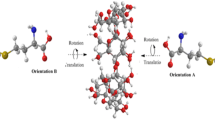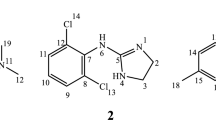Abstract
The effect of a low-molecular-mass salt on the thermodynamic stability of stoichiometric interpolymer complexes composed of oppositely charged macromolecules with different solvent affinities has been theoretically studied. It has been shown that the dissociation of such complexes with an increase in the concentration of the salt proceeds via several stages. At a low concentration of the salt, complexes retain their structure and dimensions. When a certain critical concentration of the salt n crs is achieved, the dimensions of the complex increase abruptly. At this concentration, macromolecules involved in the complex begin to separate, and at concentration n *s , they fully move apart but remain soluble owing to the polyelectrolyte effect. Upon a further increase in the concentration of the salt, the polyelectrolyte effect is shielded and the dimensions of macromolecules decrease. The critical concentration of the low-molecular-mass salt, n crs , increases with an increase in the degree of ionization of macromolecules and a decrease in the affinity of the hydrophilic component for water and diminishes with the degree of polymerization of macromolecules and the degree of hydrophobicity of a polycation. Because of the easy formation of soluble complexes from oppositely charged macromolecules differing in solvent affinities and their high stability in solutions of a low-molecularmass salt, such complexes are promising for wide use in medicine and pharmaceutical practice.
Similar content being viewed by others
References
R. M. Fuoss and H. Sadek, Science (Washington, D. C.) 110, 552 (1949).
E. A. Bekturov and L. A. Bimendina, Adv. Polym. Sci. 41, 99 (1981).
E. Tsuchida and K. Abe, Adv. Polym. Sci. 45, 1 (1982).
B. Philipp, H. Dautzenberg, K.-J. Linow, et al., Prog. Polym. Sci. 14, 91 (1989).
V. A. Izumrudov, A. B. Zezin, and V. A. Kabanov, Usp. Khim. 60, 1570 (1991).
V. A. Kabanov, in Macromolecular Complexes in Chemistry and Biology, Ed. by P. Dubin, J. Bock, R. M. Davies, D. N. Schulz, and C. Thies (Springler, Berlin, 1994), p. 151.
M. W. Hsiang and R. D. Cole, Proc. Natl. Acad. Sci. U. S. A. 74, 4852 (1977).
J.-P. Behr, Bioconjugate Chem. 5, 382 (1994).
A. V. Kabanov and V. A. Kabanov, Bioconjugate Chem. 6, 7 (1995).
A. Harada and K. Kataoka, Macromolecules 28, 5294 (1995).
A. Harada and K. Kataoka, Science (Washington, D. C.) 238, 65 (1999).
A. V. Kabanov, S. V. Vinogradov, Yu. G. Suzdaltseva, and V. Yu. Alakhov, Bioconjugate Chem. 6, 639 (1995).
A. V. Kabanov, V. K. Bronich, V. A. Kabanov, et al., Macromolecules 29, 679 (1996).
E. Yu. Kramarenko, A. R. Khokhlov, and P. Reineker, J. Chem. Phys. 119, 4945 (2003).
E. Yu. Kramarenko, A. R. Khokhlov, and P. Reineker, J. Chem. Phys. 125, 194902 (2006).
M. Castelnovo, Europhys. Lett. 62, 841 (2003).
T. Etrych, L. Leclercq, M. Boustta, and M. Vert, Eur. J. Pharm. Sci. 25, 281 (2005).
V. V. Vasilevskaya, L. Leclercq, M. Boustta, et al., Macromolecules 40, 5934 (2007).
V. Yu. Borue and I. Ya. Erukhimovich, Macromolecules 23, 3625 (1990).
V. V. Vasilevskaya and A. R. Khokhlov, Vysokomol. Soedin., Ser. A 28, 316 (1986).
A. R. Khokhlov, S. G. Starodubtzev, and V. V. Vasilevskaya, Adv. Polym. Sci. 109, 123 (1993).
V. V. Vasilevskaya, S. G. Starodubtsev, and A. R. Khokhlov, Vysokomol. Soedin., Ser. B 29, 930 (1987).
V. V. Vasilevskaya, I. I. Potemkin, and A. R. Khokhlov, Langmuir 15, 7918 (1999).
G. Bokias, V. V. Vasilevskaya, I. Iliopoulos, et al., Macromolecules 33, 9757 (2000).
Author information
Authors and Affiliations
Corresponding author
Additional information
Original Russian Text © M.K. Krotova, V.V. Vasilevskaya, A.R. Khokhlov, 2009, published in Vysokomolekulyarnye Soedineniya, Ser. A, 2009, Vol. 51, No. 10, pp. 1760–1768.
This work was supported by the Russian Foundation for Basic Research, project no. 08-03-00281-a.
Rights and permissions
About this article
Cite this article
Krotova, M.K., Vasilevskaya, V.V. & Khokhlov, A.R. The effect of a low-molecular-mass salt on stoichiometric polyelectrolyte complexes composed of oppositely charged macromolecules with different solvent affinities. Polym. Sci. Ser. A 51, 1075–1082 (2009). https://doi.org/10.1134/S0965545X09100046
Received:
Revised:
Published:
Issue Date:
DOI: https://doi.org/10.1134/S0965545X09100046




